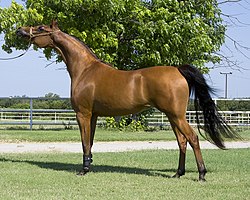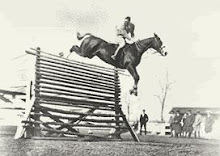Arabian horse
| Arabian horse | ||
|---|---|---|
 An Arabian Mare | ||
| Distinguishing features: | finely chisled bone structure, concave profile, arched neck, comparatively level croup, high-carried tail. | |
| Alternative names: | Arabian, Arab | |
| Country of origin: | Developed in the Middle East, most notably Arabian peninsula | |
| Breed standards | ||
| Arabian Horse Association (AHA) (United States): | Stds | |
| The Arabian Horse Society of Australia: | Stds | |
| World Arabian Horse Organization: | Stds | |
The Arabian horse is a breed of horse with a reputation for intelligence, spirit, and stamina. With a distinctive head shape and high tail carriage, the Arabian is one of the most easily recognizable horse breeds in the world. It is one of the oldest horse breeds, with archaeological evidence of horses that resemble modern Arabians dating back 4,500 years. Throughout history, Arabian horses from the Middle East spread around the world by both war and trade, used to improve other breeds by adding speed, refinement, endurance, and good bone. Today, Arabian bloodlines are found in almost every modern breed of riding horse.
The Arabian developed in a desert climate and was prized by the nomadic Bedouin people, often being brought inside the family tent for shelter and protection. This close relationship with humans has created a horse breed that is good-natured, quick to learn, and willing to please. But the Arabian also developed the high spirit and alertness needed in a horse used for raiding and war. This combination of willingness and sensitivity requires modern Arabian horse owners to handle their horses with competence and respect.
"The Versatile Arabian" is a slogan of the breed. Arabians dominate the discipline of endurance riding, and compete today in many other fields of equestrian activity. They are one of the top ten most popular horse breeds in the world. Arabian horses are now found worldwide, including the United States and Canada, the United Kingdom, Australia, continental Europe, South America (especially Brazil), and its land of origin, the Middle East.Uses
Arabians are versatile horses that compete in many equestrian fields, including Horse racing, the horse showSaddle Seat, Western Pleasure, and Hunt seat, as well as Dressage, Cutting, Reining, Endurance riding, Show jumping, Eventing, youth events such as equitation, and others. They are used as pleasure, trail riding, and working ranch horses for those who are not interested in competition. disciplines of
Competition

Arabians dominate the sport of Endurance riding because of their stamina, where they are the leading breed in competitions such as the Tevis Cup that can cover up to 100 miles (160 km) in a day.[179] They also participate in FEI-sanctioned endurance events worldwide, including the World Equestrian Games.
There is an extensive series of horse shows around the United States and Canada for Arabian, Half-Arabian, and Anglo-Arabian horses, sanctioned by the USEF in conjunction with the Arabian Horse Association. Classes offered include Western pleasure, reining, hunt seat and saddle seat English pleasure, and Halter, plus the very popular "Native" costume class. "Sport horse" events for Arabian horses are also becoming popular in North America, particularly the Arabian Horse Association began hosting a separate Arabian and Half Arabian Sport Horse National Championship in 2003 that by 2004 grew to draw 2000 entries This competition draws Arabian and part-Arabian horses that perform in Hunter, Jumper, Sport Horse Under Saddle, Sport Horse In Hand, Dressage, and Combined driving competition.
Other nations also sponsor major shows strictly for purebred and partbred Arabians, including Great Britain Spain, Poland, and the United Arab Emirates. France,
Purebred Arabians have excelled in open events against other breeds. One of the most famous examples in the field of western riding competition was the Arabian mare Ronteza, who defeated 50 horses of all breeds to win the 1961 Reined Cow Horse championship at the Cow Palace in San Francisco, CA. Another Arabian competitive against all breeds was the stallion Aaraf who won an all-breed cutting horse competition at the Quarter Horse Congress in the 1950s. In show jumping and show hunter competition, a number or Arabians have competed successfully against other breeds in open competition,including the purebred gelding Russian Roulette, who has won multiple jumping classes against horses of all breeds on the open circuit. In eventing, a purebred Arabian competed on the Brazilian team at the 2004 Athens Olympics.
Part-Arabians have also appeared at open sport horse events and even Olympic level competition. At the 1952 Olympics, the French rider Pierre d'Oriola won the Gold individual medal in show jumping on the Anglo-Arabian Ali Baba. The Anglo-Arabian Harpagon was ridden to a team gold medal and an individual silver in dressage at the 1948 Olympics. Another Anglo-Arabian, Tamarillo, ridden by William Fox-Pitt, represents the United Kingdom in FEI and Olympic competition, winning many awards, including first place at the 2004 Badminton Horse Trials. Most recently a gelding named Theodore O'Connor, nicknamed "Teddy," a 14.1 (or 14.2, sources vary) hand pony of Thoroughbred, Arabian, and Shetland pony breeding, won two gold medals at the 2007 Pan American Games and was third at the 2007 Rolex Kentucky Three Day CCI competition.
Other activities
Arabians are involved in a wide variety of activities, including fairs, movies, parades, circuses and other places where horses are showcased. Arabians have been popular in movies, dating back to the silent film era when Rudolph Valentino rode the Kellogg Arabian stallion Jadaan in 1926's Son of the Sheik. Arabians have been seen in many other films, including The Black Stallion featuring the stallion Cass Ole, The Young Black Stallion, which used over 40 Arabians during filming, as well as Hidalgo and the 1959 version of Ben-Hur.
Arabians are mascots for football teams, performing crowd-pleasing activities on the field and sidelines. One of the horses who serves as "Traveler", the mascot for the University of Southern California Trojans, has been a purebred Arabian. "Thunder", a stage name for the purebred Arabian stallion J B Kobask, was mascot for the Denver Broncos from 1993 until his retirement in 2004, when the Arabian gelding Winter Solstyce took over as "Thunder II". Cal Poly Pomona's W.K. Kellogg Arabian Horse Center Equestrian Unit has made Arabian horses a regular sight at the annual Tournament of Roses Parade held each New Year's day in Pasadena, California.
Arabians also are used on search and rescue teams and occasionally for police work. Some Arabians are also used in polo in the USA and Europe, in the Turkish equestrian sport of Cirit (pronounced Jee-rit), as well as circuses, therapeutic horseback riding programs, and on guest ranches.




